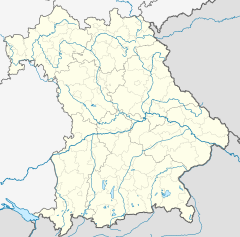History
The station was established in 1844 as the terminus of the Nuremberg–Bamberg line built by the Royal Bavarian State Railways. On 25 August 1844, the first train ran into the station, although official operations began in October 1844. Shortly after its opening in April 1845, the station became the headquarters of the Royal Bavarian State Railways in Bamberg. [5] In 1846 the line was extended to Hof in the north. Construction of the building still continued at this time and it was opened in September 1846. The building was designed by the architect Friedrich Bürklein, who designed several stations in Bavaria.
In 1852, the Würzburg-Bamberg, now Bamberg–Rottendorf railway line, was connected to Bamberg Station, which as a result became a railway junction. Therefore, the entrance building was enlarged and gained an additional storey. This conversion was completed in 1858. In 1866, the first signal box was installed at Bamberg station. [4]
From 1897 to 1922, the station forecourt was the main hub of Bamberg trams, which was served by three of the four lines of the network. The trams were closed in 1924 and replaced by buses.
In 1908 another line was opened to Schesslitz. At this time Bamberg also had a locomotive depot. [5] Due to the increase in train services the entrance building was extended again 1900-1908 and received an entrance hall. [6]
In 1939, Deutsche Reichsbahn electrified the railway station together with the lines to Hof and Nuremberg because it was a stop on the major long-distance link between Berlin and Munich. Due to the damage caused to the station during the Second World War, its importance for long-distance traffic declined in the following years. Although the reconstruction was fast, Bamberg station lost further traffic because the establishment of the Soviet occupation zone in 1946 led to the loss of long-distance services.
In 1948 the old mechanical signal boxes were replaced by a new electro-mechanical interlocking. [5]
Infrastructure
The station has seven through tracks running past four platforms, with platform 1 as the home platform. The seventh track is numbered as 8. [7] Each platform is covered and has digital platform displays. All platforms are connected via a pedestrian underpass connected to the home platform. In addition, the station is fully accessible for the handicapped by lifts.
Reception Building
The three-story historic station building is built of sandstone and is divided by three wings. It has a slightly raised central section, which is extended by a two-story entrance hall and a low pitched tiled roof. The roof of the entrance hall is made of metal. Originally the station had a "prince's room" (Fürstenzimmer), but that has not been preserved. In addition to the reception building, there are three associated buildings north of the station buildings that are protected as monuments. [6]
The station building accommodates a travel centre and shops.
Platform lengths and heights are as follows: [8]
- Track 1: length 140 m, height 55 cm
- Track 2: length 370 m, height 76 cm
- Track 3: length 405 m, height 76 cm
- Track 4 and 5: length 197 m, height 76 cm
- Track 6: length 405 m, height 76 cm
- Track 8: length 378 m, height 76 cm
This page is based on this
Wikipedia article Text is available under the
CC BY-SA 4.0 license; additional terms may apply.
Images, videos and audio are available under their respective licenses.






